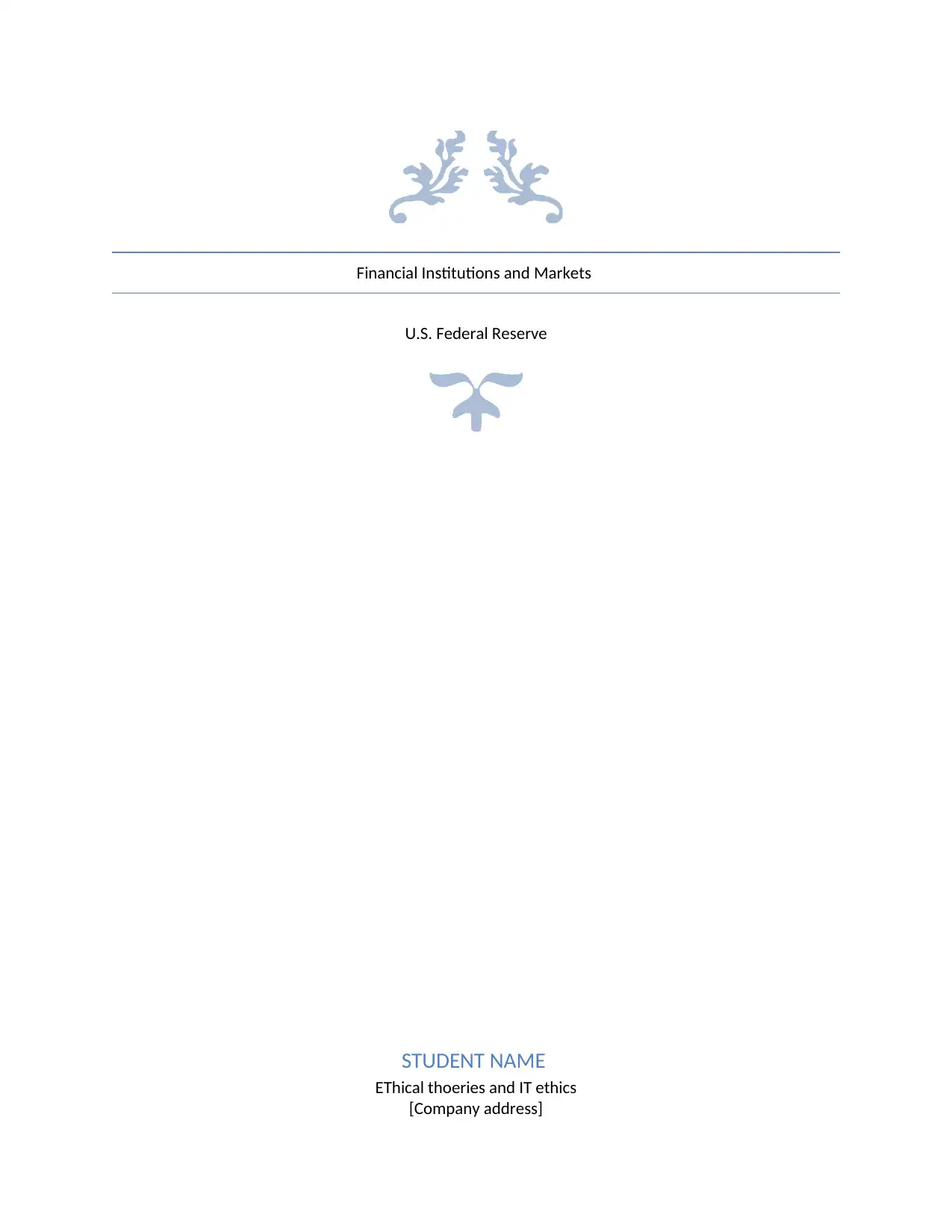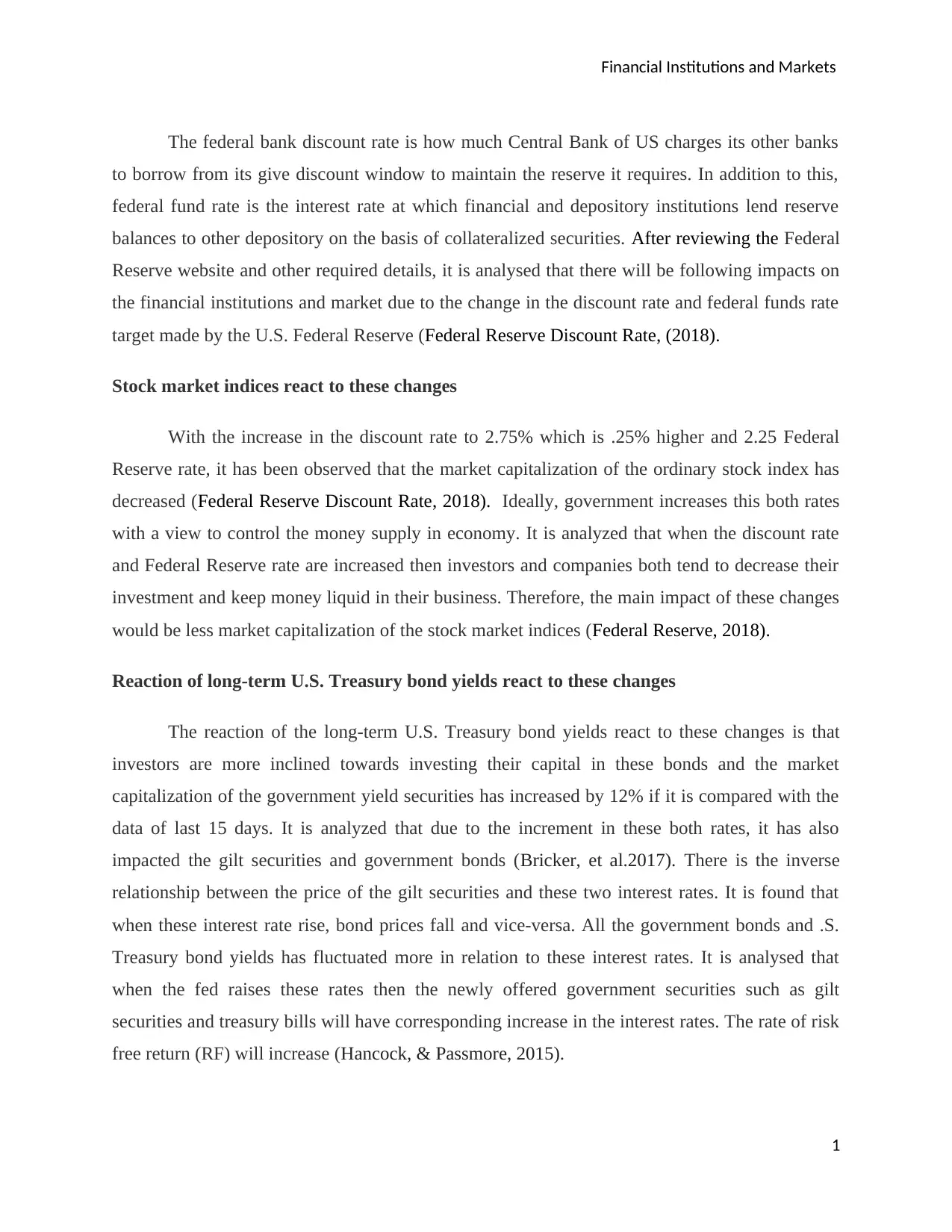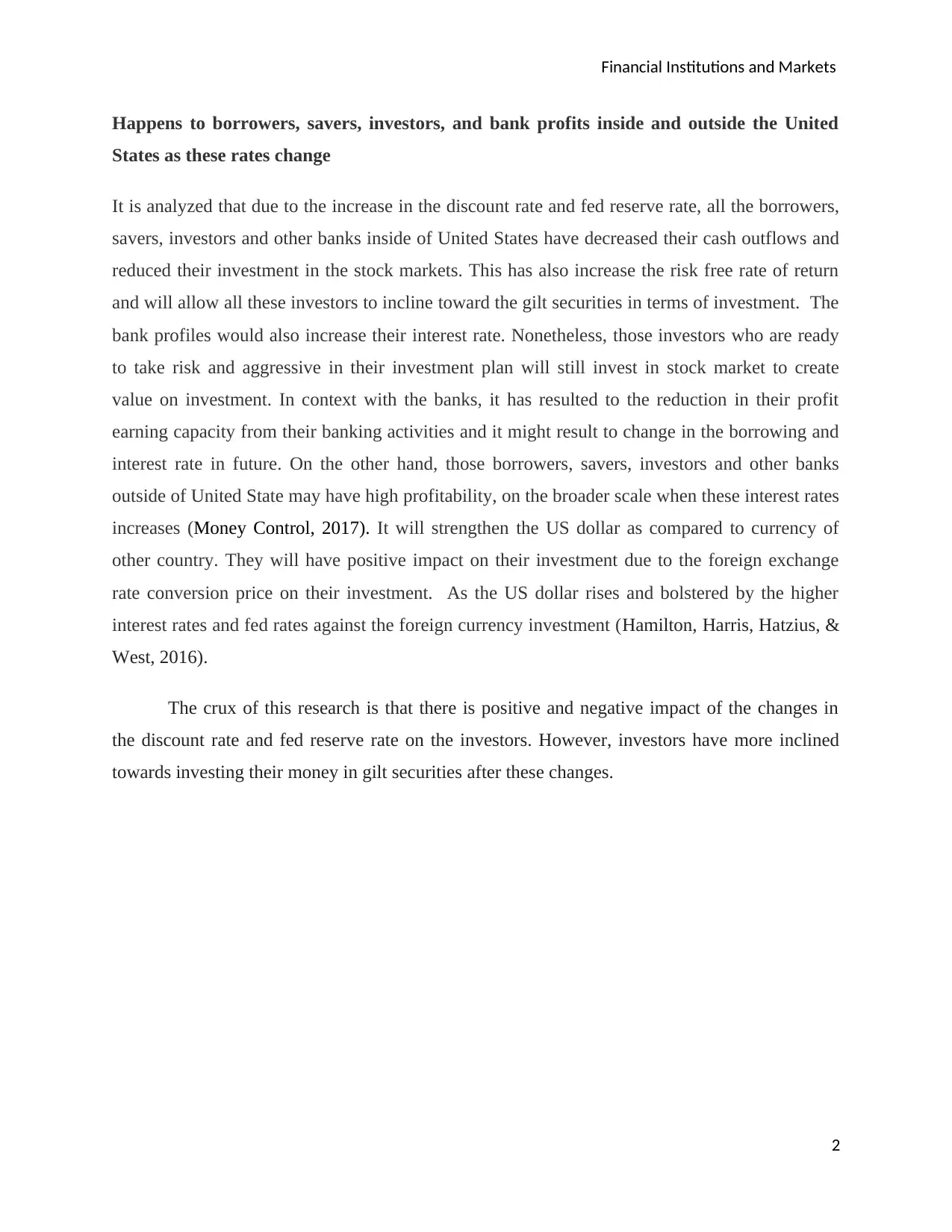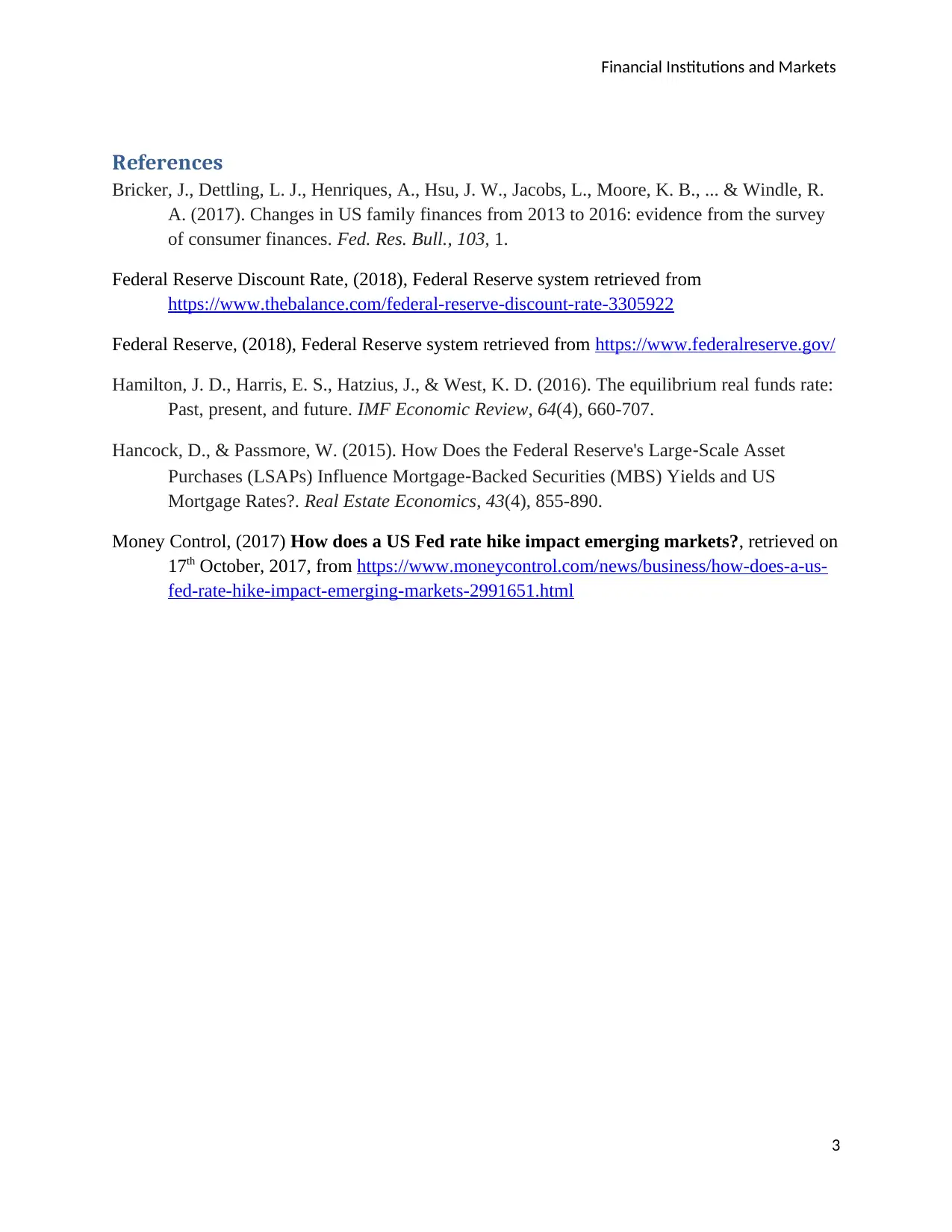Federal Reserve Rate Changes and Their Impact on Financial Markets
VerifiedAdded on 2023/06/04
|4
|1016
|332
Report
AI Summary
This report examines the effects of changes in the U.S. Federal Reserve's discount rate and federal funds rate target on financial institutions and markets. It analyzes the reactions of stock market indices and long-term U.S. Treasury bond yields to these changes, noting a decrease in stock market capitalization and an increase in investment in government yield securities. The report further explores the impact on borrowers, savers, investors, and bank profits both inside and outside the United States, observing decreased cash outflows and investment in stock markets within the U.S., and potential profitability increases for those outside the U.S. due to foreign exchange rate conversions. The research concludes that investors are more inclined towards investing in gilt securities following these changes, highlighting both positive and negative impacts on various financial entities.

Financial Institutions and Markets
U.S. Federal Reserve
STUDENT NAME
EThical thoeries and IT ethics
[Company address]
U.S. Federal Reserve
STUDENT NAME
EThical thoeries and IT ethics
[Company address]
Paraphrase This Document
Need a fresh take? Get an instant paraphrase of this document with our AI Paraphraser

Financial Institutions and Markets
The federal bank discount rate is how much Central Bank of US charges its other banks
to borrow from its give discount window to maintain the reserve it requires. In addition to this,
federal fund rate is the interest rate at which financial and depository institutions lend reserve
balances to other depository on the basis of collateralized securities. After reviewing the Federal
Reserve website and other required details, it is analysed that there will be following impacts on
the financial institutions and market due to the change in the discount rate and federal funds rate
target made by the U.S. Federal Reserve (Federal Reserve Discount Rate, (2018).
Stock market indices react to these changes
With the increase in the discount rate to 2.75% which is .25% higher and 2.25 Federal
Reserve rate, it has been observed that the market capitalization of the ordinary stock index has
decreased (Federal Reserve Discount Rate, 2018). Ideally, government increases this both rates
with a view to control the money supply in economy. It is analyzed that when the discount rate
and Federal Reserve rate are increased then investors and companies both tend to decrease their
investment and keep money liquid in their business. Therefore, the main impact of these changes
would be less market capitalization of the stock market indices (Federal Reserve, 2018).
Reaction of long-term U.S. Treasury bond yields react to these changes
The reaction of the long-term U.S. Treasury bond yields react to these changes is that
investors are more inclined towards investing their capital in these bonds and the market
capitalization of the government yield securities has increased by 12% if it is compared with the
data of last 15 days. It is analyzed that due to the increment in these both rates, it has also
impacted the gilt securities and government bonds (Bricker, et al.2017). There is the inverse
relationship between the price of the gilt securities and these two interest rates. It is found that
when these interest rate rise, bond prices fall and vice-versa. All the government bonds and .S.
Treasury bond yields has fluctuated more in relation to these interest rates. It is analysed that
when the fed raises these rates then the newly offered government securities such as gilt
securities and treasury bills will have corresponding increase in the interest rates. The rate of risk
free return (RF) will increase (Hancock, & Passmore, 2015).
1
The federal bank discount rate is how much Central Bank of US charges its other banks
to borrow from its give discount window to maintain the reserve it requires. In addition to this,
federal fund rate is the interest rate at which financial and depository institutions lend reserve
balances to other depository on the basis of collateralized securities. After reviewing the Federal
Reserve website and other required details, it is analysed that there will be following impacts on
the financial institutions and market due to the change in the discount rate and federal funds rate
target made by the U.S. Federal Reserve (Federal Reserve Discount Rate, (2018).
Stock market indices react to these changes
With the increase in the discount rate to 2.75% which is .25% higher and 2.25 Federal
Reserve rate, it has been observed that the market capitalization of the ordinary stock index has
decreased (Federal Reserve Discount Rate, 2018). Ideally, government increases this both rates
with a view to control the money supply in economy. It is analyzed that when the discount rate
and Federal Reserve rate are increased then investors and companies both tend to decrease their
investment and keep money liquid in their business. Therefore, the main impact of these changes
would be less market capitalization of the stock market indices (Federal Reserve, 2018).
Reaction of long-term U.S. Treasury bond yields react to these changes
The reaction of the long-term U.S. Treasury bond yields react to these changes is that
investors are more inclined towards investing their capital in these bonds and the market
capitalization of the government yield securities has increased by 12% if it is compared with the
data of last 15 days. It is analyzed that due to the increment in these both rates, it has also
impacted the gilt securities and government bonds (Bricker, et al.2017). There is the inverse
relationship between the price of the gilt securities and these two interest rates. It is found that
when these interest rate rise, bond prices fall and vice-versa. All the government bonds and .S.
Treasury bond yields has fluctuated more in relation to these interest rates. It is analysed that
when the fed raises these rates then the newly offered government securities such as gilt
securities and treasury bills will have corresponding increase in the interest rates. The rate of risk
free return (RF) will increase (Hancock, & Passmore, 2015).
1

Financial Institutions and Markets
Happens to borrowers, savers, investors, and bank profits inside and outside the United
States as these rates change
It is analyzed that due to the increase in the discount rate and fed reserve rate, all the borrowers,
savers, investors and other banks inside of United States have decreased their cash outflows and
reduced their investment in the stock markets. This has also increase the risk free rate of return
and will allow all these investors to incline toward the gilt securities in terms of investment. The
bank profiles would also increase their interest rate. Nonetheless, those investors who are ready
to take risk and aggressive in their investment plan will still invest in stock market to create
value on investment. In context with the banks, it has resulted to the reduction in their profit
earning capacity from their banking activities and it might result to change in the borrowing and
interest rate in future. On the other hand, those borrowers, savers, investors and other banks
outside of United State may have high profitability, on the broader scale when these interest rates
increases (Money Control, 2017). It will strengthen the US dollar as compared to currency of
other country. They will have positive impact on their investment due to the foreign exchange
rate conversion price on their investment. As the US dollar rises and bolstered by the higher
interest rates and fed rates against the foreign currency investment (Hamilton, Harris, Hatzius, &
West, 2016).
The crux of this research is that there is positive and negative impact of the changes in
the discount rate and fed reserve rate on the investors. However, investors have more inclined
towards investing their money in gilt securities after these changes.
2
Happens to borrowers, savers, investors, and bank profits inside and outside the United
States as these rates change
It is analyzed that due to the increase in the discount rate and fed reserve rate, all the borrowers,
savers, investors and other banks inside of United States have decreased their cash outflows and
reduced their investment in the stock markets. This has also increase the risk free rate of return
and will allow all these investors to incline toward the gilt securities in terms of investment. The
bank profiles would also increase their interest rate. Nonetheless, those investors who are ready
to take risk and aggressive in their investment plan will still invest in stock market to create
value on investment. In context with the banks, it has resulted to the reduction in their profit
earning capacity from their banking activities and it might result to change in the borrowing and
interest rate in future. On the other hand, those borrowers, savers, investors and other banks
outside of United State may have high profitability, on the broader scale when these interest rates
increases (Money Control, 2017). It will strengthen the US dollar as compared to currency of
other country. They will have positive impact on their investment due to the foreign exchange
rate conversion price on their investment. As the US dollar rises and bolstered by the higher
interest rates and fed rates against the foreign currency investment (Hamilton, Harris, Hatzius, &
West, 2016).
The crux of this research is that there is positive and negative impact of the changes in
the discount rate and fed reserve rate on the investors. However, investors have more inclined
towards investing their money in gilt securities after these changes.
2
⊘ This is a preview!⊘
Do you want full access?
Subscribe today to unlock all pages.

Trusted by 1+ million students worldwide

Financial Institutions and Markets
References
Bricker, J., Dettling, L. J., Henriques, A., Hsu, J. W., Jacobs, L., Moore, K. B., ... & Windle, R.
A. (2017). Changes in US family finances from 2013 to 2016: evidence from the survey
of consumer finances. Fed. Res. Bull., 103, 1.
Federal Reserve Discount Rate, (2018), Federal Reserve system retrieved from
https://www.thebalance.com/federal-reserve-discount-rate-3305922
Federal Reserve, (2018), Federal Reserve system retrieved from https://www.federalreserve.gov/
Hamilton, J. D., Harris, E. S., Hatzius, J., & West, K. D. (2016). The equilibrium real funds rate:
Past, present, and future. IMF Economic Review, 64(4), 660-707.
Hancock, D., & Passmore, W. (2015). How Does the Federal Reserve's Large‐Scale Asset
Purchases (LSAPs) Influence Mortgage‐Backed Securities (MBS) Yields and US
Mortgage Rates?. Real Estate Economics, 43(4), 855-890.
Money Control, (2017) How does a US Fed rate hike impact emerging markets?, retrieved on
17th October, 2017, from https://www.moneycontrol.com/news/business/how-does-a-us-
fed-rate-hike-impact-emerging-markets-2991651.html
3
References
Bricker, J., Dettling, L. J., Henriques, A., Hsu, J. W., Jacobs, L., Moore, K. B., ... & Windle, R.
A. (2017). Changes in US family finances from 2013 to 2016: evidence from the survey
of consumer finances. Fed. Res. Bull., 103, 1.
Federal Reserve Discount Rate, (2018), Federal Reserve system retrieved from
https://www.thebalance.com/federal-reserve-discount-rate-3305922
Federal Reserve, (2018), Federal Reserve system retrieved from https://www.federalreserve.gov/
Hamilton, J. D., Harris, E. S., Hatzius, J., & West, K. D. (2016). The equilibrium real funds rate:
Past, present, and future. IMF Economic Review, 64(4), 660-707.
Hancock, D., & Passmore, W. (2015). How Does the Federal Reserve's Large‐Scale Asset
Purchases (LSAPs) Influence Mortgage‐Backed Securities (MBS) Yields and US
Mortgage Rates?. Real Estate Economics, 43(4), 855-890.
Money Control, (2017) How does a US Fed rate hike impact emerging markets?, retrieved on
17th October, 2017, from https://www.moneycontrol.com/news/business/how-does-a-us-
fed-rate-hike-impact-emerging-markets-2991651.html
3
1 out of 4
Related Documents
Your All-in-One AI-Powered Toolkit for Academic Success.
+13062052269
info@desklib.com
Available 24*7 on WhatsApp / Email
![[object Object]](/_next/static/media/star-bottom.7253800d.svg)
Unlock your academic potential
Copyright © 2020–2025 A2Z Services. All Rights Reserved. Developed and managed by ZUCOL.





